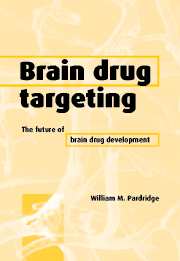Book contents
- Frontmatter
- Contents
- Preface
- List of abbreviations
- 1 Drug targeting, drug discovery, and brain drug development
- 2 Invasive brain drug delivery
- 3 Lipid-mediated transport and carrier-mediated transport of small molecules
- 4 Receptor-mediated transcytosis of peptides
- 5 Vector discovery: genetically engineered Trojan horses for drug targeting
- 6 Linker strategies: the engineering of multifunctional drug formulations
- 7 Protein neurotherapeutics and peptide radiopharmaceuticals
- 8 Antisense neurotherapeutics and imaging gene expression in vivo
- 9 Gene therapy of the brain
- 10 Blood–brain barrier genomics
- References
- Index
- Plate section
10 - Blood–brain barrier genomics
Published online by Cambridge University Press: 08 January 2010
- Frontmatter
- Contents
- Preface
- List of abbreviations
- 1 Drug targeting, drug discovery, and brain drug development
- 2 Invasive brain drug delivery
- 3 Lipid-mediated transport and carrier-mediated transport of small molecules
- 4 Receptor-mediated transcytosis of peptides
- 5 Vector discovery: genetically engineered Trojan horses for drug targeting
- 6 Linker strategies: the engineering of multifunctional drug formulations
- 7 Protein neurotherapeutics and peptide radiopharmaceuticals
- 8 Antisense neurotherapeutics and imaging gene expression in vivo
- 9 Gene therapy of the brain
- 10 Blood–brain barrier genomics
- References
- Index
- Plate section
Summary
Introduction
Blood–brain barrier (BBB) genomics involves an analysis of the tissue-specific expression of genes at the brain microvasculature, which forms the BBB in vivo. The application of genomics technology to BBB research is the single most powerful methodology ever applied to laboratory investigations of the BBB. Various physiologic, cell biological, and molecular biological methodologies have been adapted to BBB research, as reviewed previously (Pardridge, 1998d). The evolution of BBB methodology from the physiologic methods to molecular biological approaches led to incremental increases in knowledge as to how the BBB functions. However, with respect to the generation of new knowledge about BBB function that is acquired in a short time frame, the application of genomics is the most powerful new methodology ever applied to BBB research.
Purpose of BBB genomics
The discovery of genes specifically expressed at the BBB has at least two goals. First, the finding of a novel gene or a group of genes that is selectively expressed at the BBB will provide new insights into the role the microvasculature plays in brain physiology and pathology, as illustrated by the examples discussed below. Second, with respect to brain drug targeting, BBB genomics will lead to the identification of novel transporters selectively expressed at the BBB, and these discoveries will offer new targets for drug transport through the BBB in vivo. As reviewed in prior chapters of this book, and as shown in Figure 10.1, there are three general types of BBB transport processes for either large or small molecules.
- Type
- Chapter
- Information
- Brain Drug TargetingThe Future of Brain Drug Development, pp. 275 - 300Publisher: Cambridge University PressPrint publication year: 2001



